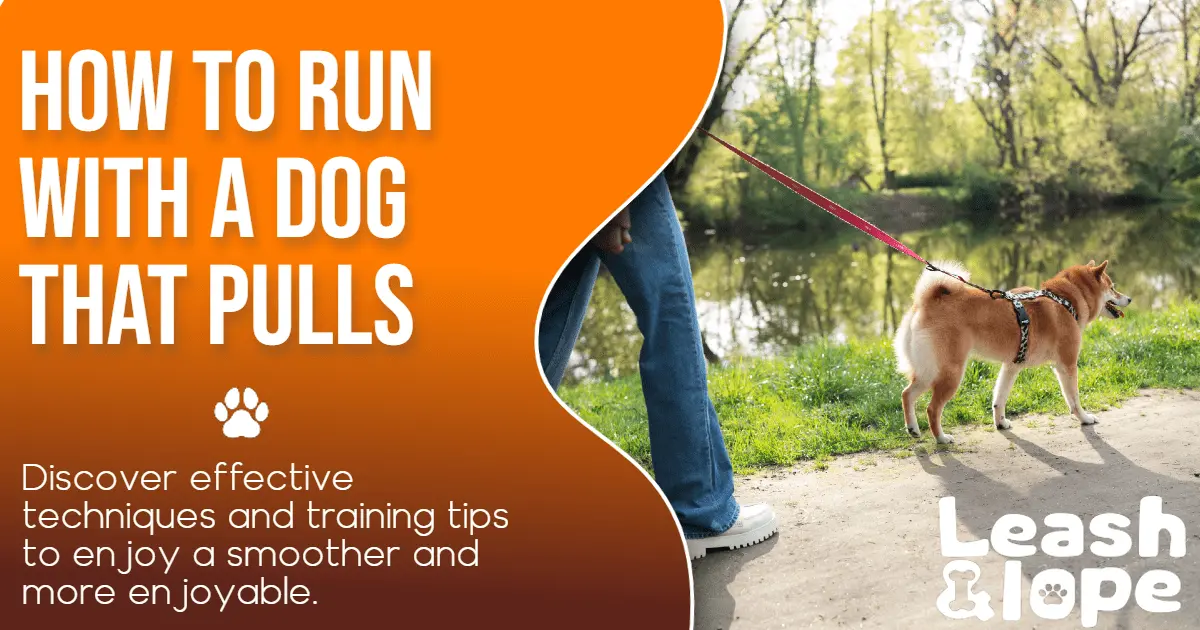Running with your canine companion companion is a great way of developing a deeper bond with him but if you have to run with a dog that pulls, it can definitely be a challenge.
Picture this: you’re all geared up, ready to hit the pavement for a refreshing run with your four-legged companion by your side. But there’s just one tiny problem – your pup has a tendency to pull on the leash, turning your peaceful jog into a chaotic tug-of-war. It’s like they’re on a mission to turn our peaceful jogs into an extreme sport, right?
Well, fear not, my friend, because this article is here to save the day. With the tips and tricks mentioned in this article, you’ll be able to turn those leash-pulling struggles into smooth sailing.
Are you ready to give it a try? Let’s dive right into this article.
Why does the dog pull while running?

Dogs pulling on the leash while running can have a few different reasons behind it. Some of them are:
Curiosity
- First of all, our furry friends are naturally curious and full of energy. That curiosity and energy can sometimes get the best of them while running.
- When our furry friends spot something intriguing, like a squirrel darting up a tree or another dog happily wagging its tail, their instinctual desire to investigate kicks in. It’s like their inner detective mode activates, and they can’t help but want to chase after whatever caught their attention.
- This excitement and curiosity can lead to pulling on the leash as they try to get closer to the object of their fascination. So, in a way, their curiosity becomes a powerful force that propels them forward and makes them pull while running.
Lack of proper on-leash training
- Some dogs simply haven’t learned the art of loose-leash walking and need a little guidance from us humans.
- When a dog hasn’t been taught how to walk politely on a leash, they may resort to pulling during runs as well.
- Without the guidance and training to understand that they should walk beside us without tugging, they might think it’s perfectly fine to forge ahead and lead the way.
- It’s not that they’re intentionally trying to make us break into a sprint; they just haven’t learned the concept of walking on a loose leash yet. So when we start running, their natural inclination might be to keep doing what they’ve always done—pulling.
Different breeds
- Additionally, certain breeds have a stronger prey drive or were bred for different activities so that can contribute to their pulling tendencies too. See best dogs breed for running.
- Take those big, strong working breeds like German Shepherds or Rottweilers, for example. They were bred for tasks that require power and endurance, so when they’re out for a run with us, they might naturally pull a bit more due to their muscular build and drive to exert energy.
- On the flip side, some smaller breeds like Dachshunds or Pugs may not have the same level of stamina or leg length as their larger counterparts. So when they try to keep up with our running pace, they might find themselves tugging a little more to keep up the momentum.
- However, you shouldn’t be solely dependent on the breed. This is because the health of your dog matters the most regardless of the breed, and running in a safe way can actually help improve the muscular as well as cardiovascular health of your dog.
- Hence, when you go to buy a dog and want him to be your running mate, you should tell the shelter staff so that they can help you pick the best one depending on your interests.
How to Really Run with a Dog that Pulls?
Now let’s see how we can prevent running with a pulling dog from turning into a wrestling match. It’s like your opponent is John Cena who goes here and there, causing your potential fall, and thinks you can’t see him. But now, thank God, you CAN see the reasons behind the pulling behavior, unlike us who still can’t see John Cena. So, now you’ll be able to take the necessary measures to defeat your opponent without even causing a fight.
1. Prefer a Harness Over a Leash
First, you need to have the right equipment needed in this case.
Using a harness instead of a leash when running with a dog that pulls can make a world of difference.
The design of a harness distributes the pressure evenly across your pup’s body, which helps to minimize any strain on their neck and throat. It is especially significant in the case of dogs with respiratory issues. It also helps prevent potential injury if your dog suddenly pulls. This is because, in this case, their neck experiences sudden pressure which can be injurious.
Plus, the harness gives you better control over your furry friend’s movements, making it easier to redirect their pulling energy in the right direction.
2. Practice Loose Leash Walking
Now, it’s time to practice loose leash walking. Attach a non-retractable leash to the harness and practice loose leash walking. This practice involves a dog walking next to its owner while maintaining a loose leash. The dog learns to stay relaxed and focused on their owner while still enjoying their walk. This technique helps prevent dogs from pulling on the leash.
The point where you attach the leash also plays a good role in this case. Front lead harnesses are preferred more when it comes to disciplining your dog.
3. Use positive reinforcement to Run with a Dog that Pulls
As you’re teaching your dog to walk by your side on a loose leash, use the basic obedience training techniques with positive reinforcement.
When you train your furry friend to respond to commands like “heel” or “stop” or “stay,” it helps them understand what you expect from them while running. You can also display it with your actions.
Positive reinforcement is all about rewarding good behavior, so when your pup walks nicely beside you without tugging your arm off, give them their favorite treat or shower them with praise. This way, they’ll associate running alongside you calmly with something awesome.
Keep the sessions short at the start. It takes time and consistency, but with some patience and a pocketful of treats, you’ll have a running buddy who won’t pull you off your feet.
4. Reduce The Distractions Around Your Pup
Reducing distractions around your dog is like creating a calm and focused running atmosphere. You already know how easily dogs can get excited by squirrels, other dogs, or even interesting smells along the way.
When there are fewer distractions during the practice, it allows your furry friend to concentrate on you and the task of running without pulling. So, choose quieter routes or areas with less commotion.
After practicing in this environment, you can gradually increase the duration of the training session. You can also start introducing some distractions to your dog after they master the art of discipline in relatively quiet environments. But still, you’d need to monitor their behavior and train them so that they won’t pull even in a crowded place. Don’t forget to give them their favorite treats after they behave nicely.
6. Stay Consistent and patient
Consistency as well as patience, are like the secret ingredient that turns a regular run into a smooth and enjoyable experience with your pulling pup.
By staying consistent with your commands, techniques, and expectations, and staying patient, your pup will start to understand that pulling won’t get them anywhere. It’s all about building that trust and understanding between you two.
7. Regular Vet Visits
Regular vet visits help ensure that your furry friend is in tip-top shape for those runs. Your vet can assess their overall health, check for any underlying issues, and provide valuable advice specific to your pup’s needs.
When it comes to running with a dog that pulls, it’s important to make sure they’re physically fit and free from any discomfort or injuries. It’s important to ensure that they’re psychologically fit as well.
Your vet can also recommend exercises or stretches to strengthen their muscles and joints, just like a personal trainer would for us humans.
It’s all about keeping them healthy, happy, and ready to conquer those pulling challenges.
Conclusion: Run with a Dog that Pulls
We’ve now reached the end of our tail-wagging article. We’ve covered some pawsome tips and tricks to help you turn those pulling moments into enjoyable runs with your furry companion.
Remember, running with a dog that pulls can be a challenge, but with patience, consistency, and a whole lot of love, you’ll be able to overcome it.
It’s important to start with proper leash training. Building a strong foundation of communication will make your runs smoother and more enjoyable for both of you. Don’t forget to reward your furry friend with treats and praise for good behavior along the way – positive reinforcement goes a long way in shaping their running manners. Always remember to prioritize safety by using a sturdy leash and harness that gives you better control.
Running with your dog is not just about getting exercise; it’s about building an unbreakable bond and creating unforgettable memories.
So enjoy every moment, embrace the joy of running side by side, and let the wind carry away all your worries.

Dr. Haider is a general doctor with a unique level of connection to our four-legged friends. He is a valued contributor to our Website (Leash and Lope). Dedicated to providing accurate to dog owners in understanding and caring for their lovely pets.

